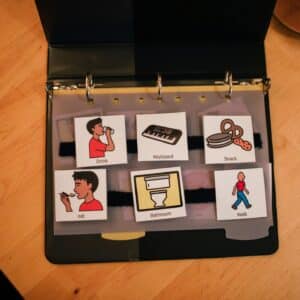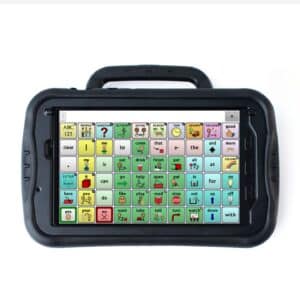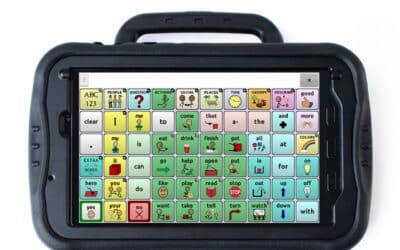For parents navigating the challenges of a child’s communication difficulties, Augmentative and Alternative Communication (AAC) can open doors you may not know existed. This article provides an in-depth look at AAC, explaining its types, applications, and the transformative impact it can have on children who struggle with traditional speech.
What is AAC?
AAC encompasses various communication methods and devices designed to assist individuals who have difficulty with speech and language. It’s especially beneficial for children with diagnoses such as apraxia, dysarthria, Down syndrome, autism, cerebral palsy, or other neurological conditions. AAC is typically divided into two categories unaided and aided.

Unaided AAC
Unaided AAC relies on the user’s body to communicate, without the need for external tools.
- Sign Language: Involves hand gestures to represent words and concepts.
- Facial Expressions, Gestures, and Body Language: Non-verbal ways to convey emotions and ideas.
Aided AAC
Aided AAC involves using external devices, ranging from low-tech options like pictures and picture boards to high-tech electronic digital devices.

Low Technology AAC
Low-tech AAC devices are non-electronic, include visuals, and simplistic, ideal for individuals who need straightforward communication tools. Low-tech methods are often used in the early stages of someone’s AAC journey. They can include:
- Pictures and Picture Boards: Individual pictures or symbols and communication boards with pictures or symbols representing words or phrases.
- Communication Books: Books containing symbols or pictures for indicating choices and expressing ideas.

Mid Technology AAC
Mid-tech AAC devices include simple electronic tools that offer more communication options compared to low-tech devices.
- Battery-operated Speech Devices: Use objects, pictures or symbols and play pre-recorded messages at the press of a button.
- Simple Voice Output Communication Aids: Devices with pictures or symbols that have multiple buttons for different messages.

High Technology AAC
High-tech AAC devices are sophisticated and customizable, suitable for advanced communication needs. They offer dynamic display in that the selection of one picture, written word, and/or symbol opens rleated pages with additional vocabulary for selection.
- Dedicated Speech-Generating Devices (SGDs): Devices that generate voice with dynamic display category pages that link one to another.
- Tablet-Based AAC Apps: Software that turns tablet computers into comprehensive communication tools using the same or similar software as dedicated devices.
Application and Benefits of AAC
Enhancing Communication Skills with AAC
Augmentative and Alternative Communication (AAC) significantly improves communication abilities for those with speech and language challenges. By providing alternative ways to understand language and express thoughts and needs, AAC helps overcome the hurdles of spoken communication, making interactions more effective and meaningful.
AAC’s Role in Language Development
AAC plays a pivotal role in the language development. It aids in helping children understand how to use language and helps them understand and independently use words and phrases.
Improving Social Interaction
The use of AAC facilitates better social interactions. By enabling clearer communication, it boosts the confidence of users in social settings and allows for the exchange of ideas. This improvement in social interaction can lead to more fulfilling relationships and a greater sense of belonging and community.
Educational Benefits of AAC
AAC devices and systems provide essential support in educational settings. They allow individuals with speech and language difficulties to actively participate in classroom learning and discussions, contributing to a more inclusive and enriching educational experience. This active participation is key to academic engagement and cognitive growth.
Reducing Communication-Related Frustration
One of the major benefits of AAC is its ability to reduce the frustration often associated with communication barriers. By offering alternative ways to understand and use language, individuals experience less stress and anxiety in their daily interactions, leading to a more positive communication experience.
Features of Different Types of AAC
Low-Tech AAC
- Accessibility: Easy to make, understand, and use, ideal for beginners.
- Cost-Effective: Less expensive than high-tech options.
- Customizability: These methods can adjust to individual preferences and daily needs.
Mid-Tech AAC
- Spoken Expression: Allows for a pre-recorded voice output.
- User-Friendly Interface: Often includes simple buttons and screens, making them easy to navigate.
- Portability: Often compact and easy to carry.
- Battery Operation: Usually runs on standard batteries.
High-Tech AAC
- Extensive Customization and Communication Options: High-tech AAC can offer solutions for a broad spectrum and more advanced communication needs.
- Dynamic Display: Offers varied and extensive symbol vocabulary libraries that link to one another offering the ability to express more complex and precise thoughts.
- Voice Output: Produces a customizable voice.
- Connectivity Options: Often includes internet and Bluetooth capabilities, expanding communication possibilities.
Funding Options for AAC
AAC systems and devices can be funded in many ways including:
- Private insurance
- Medicaid/Medicare
- Early Intervention programs
- Public schools
- Grants and scholarships
- Charitable organizations
- Local advocacy groups
- Local AAC loan programs
- Private pay
FAQs
- When should AAC be introduced?
- AAC methods are aligned to the child’s communication needs and abilities and can be introduced at any time in their development. The earlier the better to nurture communication and reduce frustration. Often, children begin with unaided and low-tech systems and advance to more sophisticated systems as indicated.
- Does AAC inhibit speech development?
- No, AAC supports speech and language development.
- How can I choose the appropriate AAC device for my three-year-old son?
- Collaborating with a Speech-Language Pathologist (SLP) or AAC diagnostic team including an SLP is crucial for choosing an effective AAC system or device for your son and supporting its implementation.
- Can AAC be integrated into educational settings?
- Yes, AAC should be part of the child’s Individualized Education Program (IEP).
- How can parents support AAC use?
- There are so many ways you can support your child’s AAC use:
- Participate the in AAC evaluation and selection process.
- Have system readily available for their child
- Educate yourself about AAC and your child’s system
- Consistently model/demonstrate use of AAC
- Respond to your child when they use AAC
- Practice AAC use every day in a variety of situations
- Provide encouragement
- Wholeheartedly participate in their child’s AAC journey.
- There are so many ways you can support your child’s AAC use:
Additional Resources
- American Speech-Language-Hearing Association (ASHA)
- AAC Institute
- ISAAC – International Society for Augmentative and Alternative Communication
- PrAACtical AAC
- Say What? Augmentative and Alternative Communication – Down Syndrome Resource Foundation (dsrf.org)
- TIES TIPS | Communicative Competence | TIP #28: Social Support for AAC Users | Institute on Community Integration Publications (umn.edu)
- The Center for AAC & Autism
Summary/Conclusion
Augmentative and Alternative Communication (AAC) provides essential support for children and adults with speech and language difficulties, offering various systems and devices to supplement or replace spoken language. As a parent, your involvement is crucial in choosing and implementing AAC, working alongside speech-language pathologists or AAC specialists, and modeling and supporting effective AAC use. By understanding the different AAC options and actively participating in your child’s communication development, you play a vital role in enhancing their ability to develop language skills and express and connect with the world around them.




0 Comments